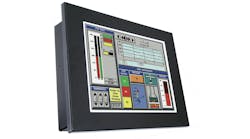A Control Design reader writes: I’ve worked in industrial machine building since before the introduction of the Internet, when machine operator controls were a switch or a pushbutton. Now, our human-machine interfaces (HMIs) control whole systems, visualize how we interact with the machines and collect data for further analysis. Our company has adopted rapidly to new HMI technology, as long as it remains cabinet-mounted. We’ve yet to try any new options for operator interfaces, such as wireless devices, cable-connect HMI pads or HMIs on a swivel arm. We do still have remote access via our cabinet-mounted HMIs, but what might some of these newer options offer that we’re missing out on? What other options are available? How do we weigh them against traditional HMI?
Answers
HMI advances follow commercial display market
As with any technological product, new features are regularly being incorporated into industrial HMI devices. Either to take advantage of new technological capabilities or to add features that improve the user experience, efficiency in operation and screen design or both.
Many of the newer features in HMI devices take advantage of developments in the commercial space. Things like widescreen-display HMIs take advantage of the development in the commercial display or television market. Multi-touch and gesture control are features found in mobile devices and are now migrating to industrial HMIs.
Some specific features don’t only include the HMI, but other parts of the control solution. An integrated development environment (IDE), for example, allows the development of the HMI screens along with the rest of the control system. This drastically increases productivity for the design engineers and reduces or eliminates the need to jump between HMI and control development environments entering the same information.
The ability to develop intuitive screens for the machine operator is a must. Some of the best HMI products available have the ability to host animations where an active visual representation of the machine or parts of the machine can be displayed to the operator.
Contextualized help and documentation features, the ability of the HMI to host other common tools, such as portable-document-format (PDF) file readers, Word or Excel displays and video playback, allow machine training and troubleshooting instruction to be incorporated right on the HMI itself.
Voice control, which may not be suitable for all industrial environments, allows operators to interact with the machine with voice commands. This feature can be particularly useful in situations where operators have limited manual dexterity or need to keep their hands free for other tasks.
Advanced data visualization is one area that is moving into the realm of industrial HMIs. The idea is to create intuitive interactive screens for the operator. Advanced charting such as treemap, circle packing and radar charts along with colors and sizing are used to assist in faster decision-making.
Security is top of mind for many manufacturers. Most HMIs have user-login capability and password-screen access based on roles. Newer recommendations from the Cybersecurity and Infrastructure Security Agency (CISA) are being incorporated into HMI designs to prevent malware intrusions and manage risk.
Let’s not forget artificial intelligence (AI). Along with the introduction of AI into machine control systems, AI has a place in the HMI. Coupled with advanced data visualization, AI has the potential to make decisions for the operator and display the decision or narrow down choices for an operator, driving the intuitive goal of machine operation.
Most HMI users probably think of this already, but weighing whether to invest in advanced HMI features usually rests on the type and purpose of the machine being designed. Factors such as function, price and degree of manufacturing integration will all play into the decision to use the advanced features.
The HMI is front and center when used in any application, one of the first things visible on a machine. It may make sense, if a high-value machining center or integrated multi-line process is being designed, the high-end featured HMI is the best choice for premium user feature and function that imparts high value to the machine.
Clark Kromenaker, product manager—HMI, IPC, controllers, software / Omron
Incorporating operational safety and security
Human-machine interface has evolved greatly since the days before the Internet. And, as you stated, there are a great many more options available than ever before. These options vary in price, capability and durability.
If we look at remote monitoring from consumer-grade tablets or even smart phones, one of the more attractive features is that operators are able to access the system utilizing apps. This frees the operator to walk the facility, spot check for physical verification of conditions, update programming and check errors all with the ability to pull up data and drawings at the swipe of a finger.
However, to be in compliance with safety regulations, a good consumer-grade HMI product would need to incorporate safety products like emergency stops (e-stops) and operator-presence triggers, also known as a dead man’s switch, along with internet security. Firewalls and good operational security are a must for any wireless product.
Products do exist on the market that satisfy the need for integrating convenience with safety and security, such as solutions that allow the user to utilize an iPad or comparable product and pair an e-stop with an operator-presence trigger to ensure compliance with regulatory safety. Some customers may want a more hardened option, including touchscreens protected by an industrial-grade housing, illuminated e-stop and pushbutton keys, SD card slot and USB interface, that works with protocols such as Profinet, EtherNet IP, message passing interface (MPI) and others. These are just a few examples. There are many more options available to you.
Eric Halvorson, partnership marketing manager II – strategic programs / DigiKey
Deterministic and low-latency cloud infrastructure for operator control virtualization
Arguably, the HMI is an industrial PC running an industrial control application. One of the biggest challenges is maintaining and securing those platforms over time, as they are rarely upgraded or patched. One of the exciting developments here is the use of cloud infrastructure local to the plant to centralize and virtualize the HMI, leaving a simple terminal in the field. This would allow much simpler upgrading and enhancing the HMI, providing more flexibility and security for the manufacturer, not to mention the cost reduction from hardware as industrial PCs tend to be more expensive than server platforms with the same performance. Naturally, the network between the machine and the local cloud infrastructure needs to resilient, secure, deterministic and low-latency, but that is available. What else could we apply that concept to?
Paul Didier, solution architect manager / Cisco
Wireless HMI applications meet TSN devices
HMI is a use case where delivering data with bounded latency and high reliability is extremely important. This is where time-sensitive networking (TSN), and in particular, wireless TSN capabilities can help. HMI was one of the initial use cases brought up by members to Avnu Alliance that motivated the development of the Wireless TSN testing program.
Wireless capabilities enable flexibility and mobility for HMI devices, reducing installation costs. The TSN features can ensure the time-critical data is prioritized and delivered with determinism on a shared network with other applications. By adopting standards-based connectivity silicon and protocols with TSN support, customers can get additional operational benefits in addition to the flexibility enabled for the HMI application.
Given the progress on TSN-capable wireless devices that we’re seeing in the Avnu Alliance plugfests, the capabilities to start deploying and testing wireless HMI applications exist. Avnu is working diligently to launch the testing and certification program for wireless TSN devices, and this is an excellent time for interested companies to engage and start testing these new capabilities and compare them with traditional HMI solutions.
Dave Cavalcanti, president and principal engineer / Avnu Alliance and Intel





